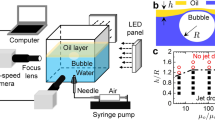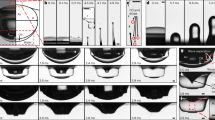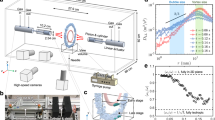Abstract
THERE are several mechanisms by which particulate matter is transferred across the sea–air interface. Filaments of liquid are torn from the tops of whitecaps by the wind and are generated by the break-up of combers. The mechanism of greatest meteorological importance is, however, the bursting, at the interface, of bubbles of air which have been trapped under the water surface or have been released from solution.
This is a preview of subscription content, access via your institution
Access options
Subscribe to this journal
Receive 51 print issues and online access
$199.00 per year
only $3.90 per issue
Buy this article
- Purchase on Springer Link
- Instant access to full article PDF
Prices may be subject to local taxes which are calculated during checkout
Similar content being viewed by others
References
Blanchard, D., in Progress in Oceanography, 1, chap. 2 (Pergamon Press, 1963).
Donnelly, R., and Glaberson, W., Proc. Roy. Soc., A, 290, 547 (1966).
Kitchener, J., and Casper, C., Quart. Rev. Chem. Soc. London, 13, 77 (1959).
Day, J. A., Quart. J. Roy. Met. Soc., 90, 72 (1964).
Blanchard, D., in Progress in Oceanography, 1, 125 (Pergamon Press, 1963).
Day, J. A., Quart. J. Roy. Met. Soc., 90, 75 (1964).
Author information
Authors and Affiliations
Rights and permissions
About this article
Cite this article
DAY, J. Bursting Air Bubbles studied by the Time Exposure Technique. Nature 216, 1097–1099 (1967). https://doi.org/10.1038/2161097b0
Received:
Revised:
Published:
Issue Date:
DOI: https://doi.org/10.1038/2161097b0
Comments
By submitting a comment you agree to abide by our Terms and Community Guidelines. If you find something abusive or that does not comply with our terms or guidelines please flag it as inappropriate.



